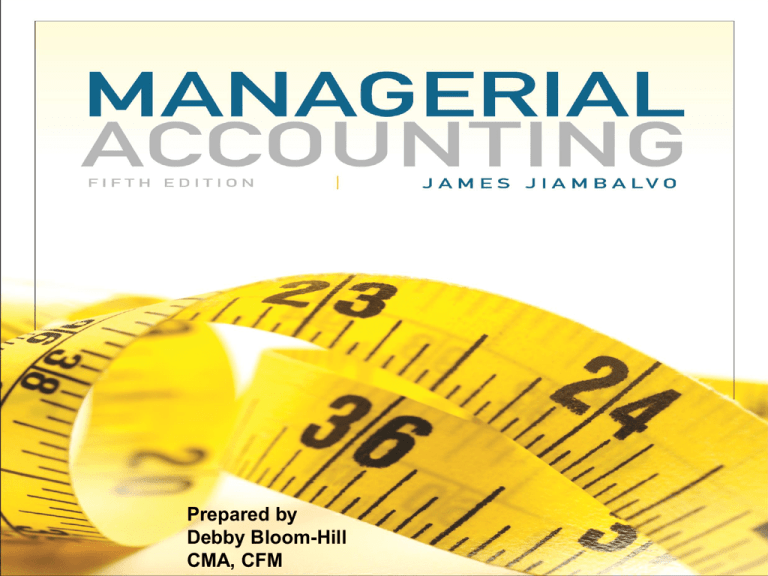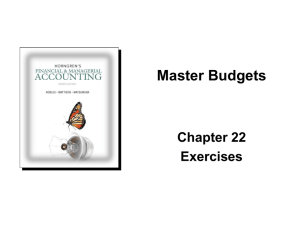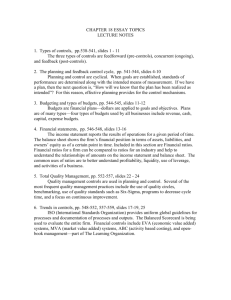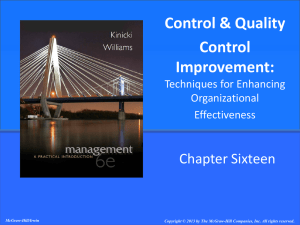
Prepared by
Debby Bloom-Hill
CMA, CFM
CHAPTER 10
Budgetary Planning and Control
Slide 10-2
Budgetary Planning and
Control
Budgets are the formal documents that
quantify a company’s plans for
achieving its goals
For many companies, the entire
planning and control process is built
around budgets.
Slide 10-3
Learning objective 1: Discuss the use of
budgets in planning and control
Use of Budgets in Planning
and Control
Planning
Budgets enhance communication and
coordination
The process of developing a formal plan
forces managers to consider their goals
and objectives and to specify means of
achieving them
Budgets become the vehicle for
communicating information about
where the company is heading
Slide 10-4
Learning objective 1: Discuss the use of
budgets in planning and control
Use of Budgets in Planning
and Control
Control
Budgets provide a basis for evaluating
performance
Control makes sure the company is
heading in the proper direction and
operating efficiently
To control a company, it is essential to
assess the performance of managers and
their operations for which they are
responsible
Slide 10-5
Learning objective 1: Discuss the use of
budgets in planning and control
Use of Budgets in Control
Often performance evaluation is carried
out by comparing actual with planned or
budgeted performance
Significant deviations from planned
performance associated with three potential
causes:
1. The budget was poorly conceived
2. Conditions have changed
3. Managers have done a particularly good or
poor job managing operations
Slide 10-6
Learning objective 1: Discuss the use of
budgets in planning and control
Which of the following statements regarding
budgets is false?
a. They are formal documents that quantify a
company’s plans.
b. They enhance communication and
coordination.
c. They are useful in planning but not in
control.
d. They provide a basis for evaluating
performance.
Answer: c
They are useful in planning AND in control
Slide 10-7
Learning objective 1: Discuss the use of
budgets in planning and control
Developing the Budget
Budgets are prepared for:
Departments
Divisions of a company
For the entire company
Often the group within a company that
is responsible for approval of the
various budgets is the budget
committee
Slide 10-8
Learning objective 1: Discuss the use of
budgets in planning and control
Developing the Budget
The budget committee consists of
senior managers
The budget committee works with
departments to develop realistic plans
that are consistent with overall
company goals
In some cases the budget committee
may impose a budget without soliciting
input from department managers
Slide 10-9
Learning objective 1: Discuss the use of
budgets in planning and control
Developing the Budget
In a top-down approach budgets are
developed at higher operational levels
without substantial input from lower
level managers
In a bottom-up approach, lower level
managers are the primary source of
information used in setting the budget
Slide 10-10
Learning objective 1: Discuss the use of
budgets in planning and control
Budget Time Period
Managers must decide on an
appropriate budget period
Depending on needs, budgets can be
prepared for a variety of time periods
Long run budgets are prepared for a
three or even a five year period
Short run budgets may cover a month, a
quarter, or a year
Generally, the longer the time period,
the less detailed the budget
Slide 10-11
Learning objective 1: Discuss the use of
budgets in planning and control
Five-Year Budgets
Slide 10-12
Learning objective 1: Discuss the use of
budgets in planning and control
Zero Base Budgeting
A common starting point in budgeting
is previous period revenues and costs
Zero base requires budgeted amounts to
be justified by each department at the
start of each period
This results in a fresh consideration for
the validity of budgeted amounts
It is a time consuming and expensive
process
Not widely used by business enterprises
Slide 10-13
Learning objective 1: Discuss the use of
budgets in planning and control
The Master Budget
The master budget is a comprehensive
planning document that incorporates a
number of individual budgets
Typically, it includes budgets for sales,
production, direct materials, direct labor,
manufacturing overhead, selling and
administrative expense, capital
acquisitions, and cash receipts and
disbursements
Also includes budgeted income statement
and balance sheet
Learning objective 2: Prepare the budget schedules
that make up the master budget
Slide 10-14
Master Budget
Slide 10-15
Learning objective 2: Prepare the budget schedules
that make up the master budget
Sales Budget
The first step involved preparation of
sales forecasts and a sales budget
Prepared first because an estimate of
sales is needed for other budgets
Companies use numerous methods to
estimate sales, including
Economic models
Sales trends
Trade journals, among others
Slide 10-16
Learning objective 2: Prepare the budget schedules
that make up the master budget
Sales Budget
Budgeted sales revenue:
Budgeted sales (units) x budgeted sales price
Slide 10-17
Learning objective 2: Prepare the budget
schedules that make up the master budget
Production Budget
The production budget can be
developed once the sales budget has
been prepared
In deciding how much to produce,
managers must take into account how
much they expect to sell, how much is
in beginning inventory, and how much
they want in ending inventory
Slide 10-18
Learning objective 2: Prepare the budget
schedules that make up the master budget
Production Budget
The quantity that must be produced is
calculated using the following formula
Desired
Beginning
Finished
Expected
ending
inventory
units to be = sales in + inventory of of finished
produced
units
finished
units
goods
Slide 10-19
Learning objective 2: Prepare the budget
schedules that make up the master budget
Production Budget
Preston Joystick budget plan, Quarter 1
Ending inventory of finished goods = 10% of
next quarter’s sales (25,000 X 10% = 2,500)
Budgeted unit sales,Q1 = 21,000 units
Budgeted unit sales, Q2 = 25,000 units
Beginning inventory Q1 = 2,100 units
Budget finished units to be produced
Expected sales in units
Add: Desired ending inventory of finished goods
Subtract: Beginning inventory of finished units
Finished units to be produced
Slide 10-20
21,000
2,500
(2,100)
21,400
Learning objective 2: Prepare the budget schedules
that make up the master budget
Mason Manufacturing expects to sell 10,000 units in the
first quarter and 14,000 in the second quarter. The
company desires beginning inventory equal to 20% of
sales for the coming quarter. Finished goods on hand at
the start of the first quarter equals 2,000 units. How
many units should be produced in the first quarter?
a. 14,000 units
b. 16,000 units
c. 10,800 units
d. 12,000 units
Answer: c
10,800 units = 10,000 + 2,800 – 2,000
Slide 10-21
Learning objective 2: Prepare the budget schedules
that make up the master budget
Direct Material Purchases Budget
The amount of direct materials that must
be purchased depends on
The amount needed for production, and
The amount needed for ending inventory
The amount that must be purchased can
be calculated from the following formula
Required
purchases
of direct
materials
Slide 10-22
Desired
Amount
ending
required
=
+ inventory
for
of direct
production
materials
-
Beginning
inventory
of direct
materials
Learning objective 2: Prepare the budget
schedules that make up the master budget
Budgeted production: Q1= 50,000; Q2= 60,000
Parts per unit= 3 , cost per part= $5
Ending inventory = 20% of next month’s production
Number of parts required for Q1 production is:
a. 50,000
b. 150,000
c. 60,000
d. 180,000
Answer: b
Q1 production 50,000 x 3 parts per unit = 150,000
Slide 10-23
Learning objective 2: Prepare the budget schedules
that make up the master budget
Budgeted production: Q1= 50,000; Q2= 60,000
Parts/unit= 3, cost/part= $5
Ending inventory = 20% of next month’s required parts
Desired ending inventory of parts for Q1 in units is:
a. 10,000
b. 12,000
c. 30,000
d. 36,000
Answer: d
Q2 parts = 60,000 x 3 = 180,000 x 20% = 36,000
Slide 10-24
Learning objective 2: Prepare the budget schedules
that make up the master budget
Budgeted production: Q1= 50,000; Q2= 60,000
Parts/unit= 3, cost/per part= $5
Ending inventory = 20% of next month’s required part
Beginning parts inventory, Q1= 30,000 units
Budgeted cost of purchases for Q1 is:
a. $750,000
b. $900,000
c. $780,000
d. $1,650,000
Answer: c
156,000 parts to purchase = 150,000 + 36,000 – 30,000
156,000 parts to purchase x $5 cost = $780,000
Slide 10-25
Learning objective 2: Prepare the budget schedules
that make up the master budget
Direct Labor Budget
The direct labor budget presents the
direct labor cost by quarter
Direct labor cost is calculated by
multiplying the number of units produced
each quarter by the labor hours per unit
and the rate per hour
The direct labor budget can be used to
budget the number of employees needed
Slide 10-26
Learning objective 2: Prepare the budget schedules
that make up the master budget
Direct Labor Budget
Slide 10-27
Learning objective 2: Prepare the budget schedules
that make up the master budget
Manufacturing Overhead Budget
The manufacturing overhead budget
separates variable and fixed costs
The cost per unit of production of each
variable cost item is multiplied by the
quantity produced each quarter
The fixed costs are identical each quarter
except for the amount of depreciation
Budget information is also needed for
selling and administrative expenses
Slide 10-28
Learning objective 2: Prepare the budget schedules
that make up the master budget
Manufacturing Overhead Budget
Slide 10-29
Learning objective 2: Prepare the budget schedules
that make up the master budget
Selling and Administrative
Expense Budget
Slide 10-30
Learning objective 2: Prepare the budget schedules
that make up the master budget
Budgeted Income Statement
Much of the information contained in
the budgets already described is
utilized in the preparation of a
budgeted income statement
The sales figures come directly from the
sales budget
Cost of goods sold requires a
calculation of the unit cost of
production
Slide 10-31
Learning objective 2: Prepare the budget schedules
that make up the master budget
Budgeted Income Statement
Calculation of the unit cost of
production
The direct materials budget indicates
the materials cost per unit
The direct labor budget indicates the
labor cost per unit
The manufacturing overhead budget
indicates the overhead cost per unit
Slide 10-32
Learning objective 2: Prepare the budget schedules
that make up the master budget
Capital Acquisitions Budget
For decisions with respect to long-lived
assets such as plant and equipment
Incremental cash flows along with net
present value and internal rate of
return are used for evaluation
The final list of approved projects is
documented in the capital acquisitions
budget
Slide 10-33
Learning objective 2: Prepare the budget schedules
that make up the master budget
Cash Receipts and Disbursements
Budget
Managers must plan for the amount
and timing of cash flows
Careful planning of receipts and
disbursements is necessary to:
Anticipate cash shortages and arrange
to borrow funds
Anticipate cash surpluses and seek
productive uses
Slide 10-34
Learning objective 2: Prepare the budget schedules
that make up the master budget
Which of the following items does not
require a cash outflow?
a.
b.
c.
d.
Salaries
Purchase of raw materials
Advertising
Depreciation
Answer: d
Depreciation
Slide 10-35
Learning objective 2: Prepare the budget schedules
that make up the master budget
Estimate Cash Collections
To prepare an estimate of cash
collections, management must
determine the percent of credit sales
revenue that is collected in the period of
sale and the percent collected in the
subsequent period
The percentage can be estimated based
on past collection experience
Slide 10-36
Learning objective 2: Prepare the budget schedules
that make up the master budget
Estimate Cash Disbursements
To prepare an estimate of cash
disbursements, management must
determine the percent of material
purchases that is paid in the period of
purchase and the percent that is paid in
the subsequent period
The timing of all other cash
disbursements must also be considered
Slide 10-37
Learning objective 2: Prepare the budget schedules
that make up the master budget
Estimate Cash Disbursements
In preparing a cash budget, it is
important to remember that some
expenses do not require cash outlays
For example, depreciation is a part of
manufacturing overhead but does not
require a current outlay of cash
Another example of a noncash expense
is the amortization of prepaid insurance
Slide 10-38
Learning objective 2: Prepare the budget schedules
that make up the master budget
Mason Manufacturing expects sales of $100,000 in the
first quarter and $140,000in the second quarter. The
company collects 70% of sales in the quarter sold and
30% in the subsequent quarter. What are expected cash
collections in the second quarter?
a.
b.
c.
d.
$128,000
$30,000
$98,000
$142,000
Answer: a
$128,000 = (.3 * $100,000) + (.7 * $140,000)
Slide 10-39
Learning objective 2: Prepare the budget schedules
that make up the master budget
Budgeted Balance Sheet
The last component of the master
budget is the budgeted balance sheet
This is simply a planned balance sheet
Sometimes called a pro forma balance
sheet
Managers can use this budget to assess
the effect of their planned decisions on
the future financial position of the firm
Slide 10-40
Learning objective 2: Prepare the budget schedules
that make up the master budget
Use of Computers in the Budget
Planning Process
Budget committee may review a budget
and decide it is inconsistent with
company goals
This conclusion may lead managers to
explore a variety of actions that affect
future costs and revenues
If managers decide to make changes,
they must also revise the budget
Slide 10-41
Learning objective 2: Prepare the budget schedules
that make up the master budget
Use of Computers in the Budget
Planning Process
Computers are very useful in this
situation
Most companies define the budget
relationships in a computer model
With computerized budget
information, an item can be changed
and the computer can recalculate that
budget and any other budget affected by
the change
Slide 10-42
Learning objective 2: Prepare the budget schedules
that make up the master budget
Budgetary Control
Budgets facilitate control by providing a
standard for evaluation
The standard is the budgeted amount,
against which actual results are
compared
Differences between budgeted and actual
amounts are referred to as budget
variances
Slide 10-43
Learning objective 2: Prepare the budget schedules
that make up the master budget
Static and Flexible Budgets
In evaluating performance, care must
be taken to make sure that the level of
activity used in the budget is equal to
the actual level of activity
A static budget is not adjusted for the
actual level of production
A more appropriate analysis would
make use of a flexible budget
Slide 10-44
Learning objective 3: Explain why flexible budgets are
needed for performance evaluation
Flexible Budgets
A flexible budget is a set of budget
relationships that can be adjusted to
various activity levels
Thus, flexible budgets take into account
the fact that when production increases
or decreases, variable costs can change
Fixed costs, however, stay the same
Slide 10-45
Learning objective 3: Explain why flexible budgets are
needed for performance evaluation
Flexible Budget
Slide 10-46
Learning objective 3: Explain why flexible budgets are
needed for performance evaluation
A ____ budget is not adjusted for the
actual level of production.
a.
b.
c.
d.
Static
Flexible
Pro forma
None of the above
Answer: a
Static
Slide 10-47
Learning objective 3: Explain why flexible budgets are
needed for performance evaluation
Spreadsheets
Slide 10-48
Learning objective 3: Explain why flexible budgets are
needed for performance evaluation
Investigating Budget Variances
Significant deviations from the budget,
called budget variances, may have
three causes
1. The budget may not have been well
conceived
2. Conditions may have changed
3. Managers may have performed their
jobs particularly well or poorly
Slide 10-49
Learning objective 3: Explain why flexible budgets are
needed for performance evaluation
Investigating Budget Variances
Using a management by exception
approach, only exceptional variances
are investigated
Generally, variances that are large in
absolute dollars or relative to budgeted
amounts are considered exceptional
It is important to point out that both
exceptional “unfavorable” and
exceptional “favorable” variances should
be investigated
Slide 10-50
Learning objective 3: Explain why flexible budgets are
needed for performance evaluation
“Unfavorable” Budget Variance
Slide 10-51
Learning objective 3: Explain why flexible budgets are
needed for performance evaluation
Conflict in Planning and Control
Uses of Budgets
Budgets are used for both planning and
control
With respect to planning, they
communicate company goals and help
coordinate various activities
With respect to control, they focus the
attention of managers on meeting or
beating budget targets
There are inherent conflicts when budgets
are used for both planning and control
Slide 10-52
Learning objective 4: Discuss the conflict between the planning
and control uses of budgets
Issues With Budget-Based
Compensation
The following slide helps
understanding of the two related
problems
The illustration shows a common
budget based compensation scheme in
which a manager receives a “hurdle”
bonus once a target is hit
Performance better than 80% of
budgeted profit results in additional
“variable” bonus
Slide 10-53
Learning objective 4: Discuss the conflict between the planning
and control uses of budgets
Common Budget-based
Compensation Scheme
Slide 10-54
Learning objective 4: Discuss the conflict between the planning
and control uses of budgets
Issues With Budget-Based
Compensation
The first problem is that managers
have incentive to pad a budget and
create budget slack
Budget slack is a budget with targets
that are easy to achieve
The lower the budget target, the more
likely it is that managers will receive
the hurdle and variable bonus
Managers can create slack by lowering
sales and increasing cost forecasts
Slide 10-55
Learning objective 4: Discuss the conflict between the planning
and control uses of budgets
Issues With Budget-Based
Compensation
The second problem relates to the fact
that managers who are evaluated may
have an incentive to shift income from
one period to another
Consider a manager who estimates that
it is unlikely that the target will be met
The manager has an incentive to shift
income from a future period to the
current period
Slide 10-56
Learning objective 4: Discuss the conflict between the planning
and control uses of budgets
Issues With Budget-Based
Compensation
The best that can be done to mitigate
the conflict between the planning and
control uses of budgets is to assure
managers that their performance in
comparison to the budget will be fairly
evaluated and compensated
Managers should be confident that they
will be allowed to comment on the real
causes of budget variances and tell
their side of the story
Slide 10-57
Learning objective 4: Discuss the conflict between the planning
and control uses of budgets
Budget Padding
Slide 10-58
Learning objective 4: Discuss the conflict between the planning
and control uses of budgets
Copyright
© 2010 John Wiley & Sons, Inc. All rights
reserved. Reproduction or translation of this
work beyond that permitted in Section 117 of the
1976 United States Copyright Act without the
express written permission of the copyright
owner is unlawful. Request for further
information should be addressed to the
Permissions Department, John Wiley & Sons,
Inc. The purchaser may make back-up copies for
his/her own use only and not for distribution or
resale. The Publisher assumes no responsibility
for errors, omissions, or damages, caused by the
use of these programs or from the use of the
information contained herein.
Slide 10-59






